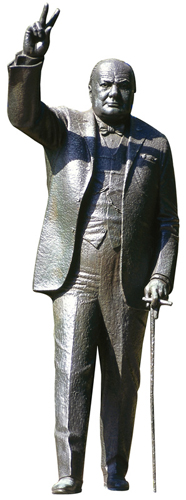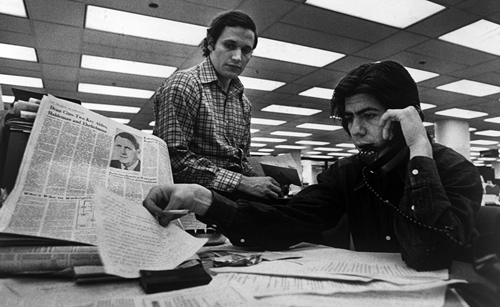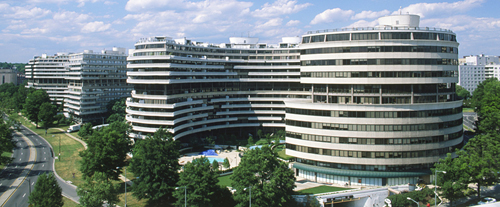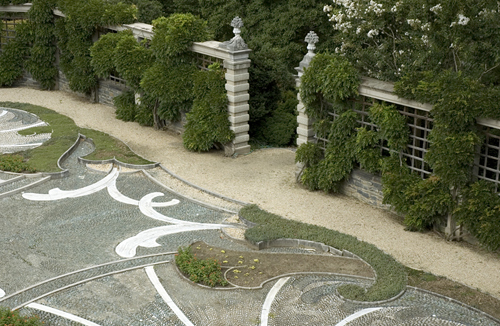Embassy Row Since
the 19th century, Embassy Row, the string of great mansions heading
west from Dupont Circle up Massachusetts Avenue, has been a hotbed of
gathering and suppressing information. Today, 46 embassies and
chanceries here help shape foreign policy by allowing issues to be
discussed without the glare of public announcement.

Churchill statue, Embassy Row
Watergate and Washington Post Newsroom The
Watergate complex became the most infamous apartment and office complex
in the world when a bungled burglary there, as part of an espionage
campaign against President Nixon’s opponents, led to his resignation . The newspaper that played the main role in revealing the scandal, the Washington Post, offers tours to groups on Mondays (write to request a tour two weeks in advance). WatergateWashington Post newsroom1150 15th St, NW 202 334 7969

Washington Post newsroom during the Watergate scandal

Watergate complex
Katherine Graham House The Georgetown home of Katherine Graham, publisher of the Washington Post from 1963 to 2001, provided a salon for politicians of every persuasion to discuss issues of the day. 2920 R St, NW Closed to the public
Dumbarton Oaks In
1944, representatives of China, the Soviet Union, United Kingdom, and
the United States developed proposals at Dumbarton Oaks for an
international body to bring peace among nations. The result was the
United Nations .

Dumbarton Oaks
International Spy Museum This
fascinating museum examines clandestine operations in political and
military decisions. Artifacts include an example of Enigma, the World
War II German encryption device, and a camera designed to photograph
through walls. Private Clubs Lobbyists
regularly frequent private clubs in the downtown area, such as the
National Democratic Club and Army and Navy Club, as well as country
clubs such as the Congressional Country Club, where a little discreet
politicking is accepted and expected. House of the Temple Library This
is a serious library with many rare items, but its appeal lies in the
insights it offers into famous Washingtonians, especially the large
display on J. Edgar Hoover.

House of the Temple Library
FedEx Field The Washington Redskins
are something of a local religion. At home games, the cigar bar, club
seating levels, and luxurious suite- and box-seating are filled with
lobbyists, campaign donors, and activists schmoozing with each other. Political Dining The Monocle has a history of fostering alliances and deals – it is the closest restaurant to the Senate side of the Capitol. The Caucus Room is largely funded by political insiders, and popular for high-profile power-dining. The MonocleThe Inn at Little Washington This
famed restaurant, west of the city, is a prime spot for entertaining to
impress, and the one-hour drive there and back provides time for
lobbyists to bond and bargain – assuming the car is bug-free.
Top 10 Congressional Leaders in History
James K. Polk A
supporter of Andrew Jackson, Polk (1795–1849) led the fight in the
administration’s conflict with the banks. He became president in 1845. Daniel Webster Webster (1782–1852) is credited as the finest speaker in defense of the Union in debates over slavery. Henry Clay A great orator (1777–1852) known for his proposals for compromise over slavery. William Boyd Allison Allison (1829–1908) was a major force in shaping US laws passed in the 19th century. Henry Cabot Lodge This distinguished patrician (1850–1924) opposed corrupt influences of big business. George W. Norris Norris (1861–1944) was author of the 20th Amendment to the US Constitution, clarifying issues related to tenure in office. Joseph Taylor Robinson The death of this leader (1872–1937) was attributed to overwork associated with New Deal proposals. Margaret Chase Smith Smith (1897–1995) publicly condemned the anti-Communist smear tactics of Senator Joseph McCarthy. Sam T. Rayburn Rayburn (1882–1961) witnessed the administrations of eight presidents. John W. McCormack McCormack (1891–1980) was instrumental in passing the Civil Rights Acts of 1964 and 1968.
|